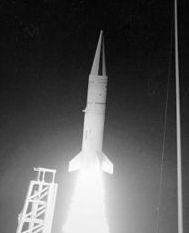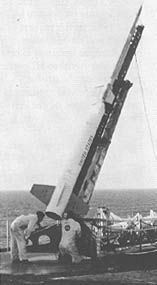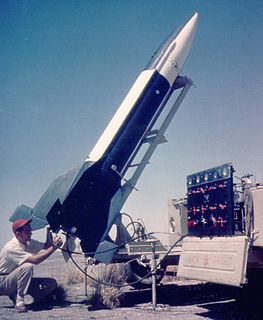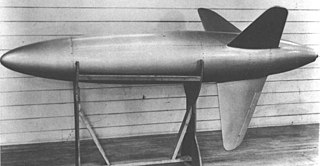
The Aerobee rocket family was one of the outstanding achievements of early American rocketry. It not only was a primary sounding rocket of the 1940s and 1950s; Aerobees were launched into the mid-1980s with the last flight in 1985. The early RTV-N-10 Aerobee was a 6.14m unguided sounding rocket used for high atmospheric and cosmic radiation research in the United States in the 1940s. The Aerojet designation for the first Aerobees was XASR-1 which was also the designation of its engine. The name was a contraction of Aerojet and Bumblebee, the names of the prime contractor and manufacturer of the engine and Bumblebee a Navy guided missile program. As with its progenitor WAC Corporal the Aerobee required a large launch tower for initial guidance. The Aerobee was the first rocket fired by the US Navy at White Sands. Aerobee was boosted by a 2.5KS-18000 (X103C10) solid rocket. Aerobee was initially powered by the XASR-1 a version of the 21AL-2600 engine of the Nike Ajax. That engine was replaced by developed versions such as the AJ10-25 and AJ10-34. The Aerobee was the subject of the first comprehensive missile range safety program. The US Navy designation was RTV-N-8. The US Air Force also operated Aerobees under program MX-1011 as X-8 (RTV-A-1). The USAF system of fuel tank pressurization with helium instead of compressed air was adapted by the USN and the Navy Aerobee was redesignated RTV-N-10.

The Aerojet General X-8 was an unguided, spin-stabilized sounding rocket designed to launch a 150 lb (68 kg) payload to 200,000 feet (61.0 km). The X-8 was a version of the prolific Aerobee rocket family.

Aries is an American sounding rocket and target rocket, developed by Space Vector Corporation from retired LGM-30 Minuteman I intercontinental ballistic missile (ICBM) stages for use by the United States Air Force and NASA. Taken over by Orbital Sciences Corporation, Aries, as the Target Test Vehicle, remains in use.

The Nike Apache, also known as Argo B-13, was a two-stage sounding rocket developed by Aerolab, later Atlantic Research, for use by the United States Air Force and NASA. It became the standard NASA sounding rocket and was launched over 600 times between 1961 and 1978.
Cajun Dart is the designation of an American sounding rocket. The Cajun Dart was used 87 times between 1964 and 1970. The Cajun rocket motor was developed from Deacon.
The Nike-Cajun was a two-stage sounding rocket built by combining a Nike base stage with a Cajun upper stage. It was launched 714 times between 1956 and 1976 and was the most frequently used sounding rocket of the western world. The Nike Cajun had a launch weight of 698 kg (1538 lb), a payload of 23 kg (51 lb), a launch thrust of 246 kN (55,300 lbf) and a maximum altitude of 120 km (394,000 ft). It had a diameter of 42 cm and a length of 7.70 m. The maximum speed of the Nike-Cajun was 6,760 km/h (4,200 mph).

Arcas was the designation of an American sounding rocket, developed by the Atlantic Research Corp., Alexandria, Va..
A number of Suborbital spaceflights were conducted during 2008. These consist mostly of sounding rocket missions and missile tests, and include other flights such as an ASAT firing. Between the start of the year and 16 July, at least 43 publicly announced suborbital spaceflights were conducted, the first of them on 11 January.

The Bold Orion missile, also known as Weapons System 199B (WS-199B), was a prototype air-launched ballistic missile (ALBM) developed by Martin Aircraft during the 1950s. Developed in both one- and two-stage designs, the missile was moderately successful in testing, and helped pave the way for development of the GAM-87 Skybolt ALBM. In addition, the Bold Orion was used in early anti-satellite weapons testing, performing the first interception of a satellite by a missile.

The High Virgo, also known as Weapons System 199C (WS-199C), was a prototype air-launched ballistic missile (ALBM) jointly developed by Lockheed and the Convair division of General Dynamics during the late 1950s. The missile proved moderately successful and aided in the development of the later GAM-87 Skybolt ALBM. It was also used in early tests of anti-satellite weapons.

The Alpha Draco missile, also known as Weapons System 199D (WS-199D), was an experimental ballistic missile developed by McDonnell Aircraft in the late 1950s to investigate the aerodynamic physics of the boost-glide reentry trajectory. Three test flights were conducted in 1959, of which two were successful.

The Advanced Strategic Air-Launched Missile (ASALM) was a medium-range strategic missile program, developed in the late 1970s for the United States Air Force. Intended for use in both the air-to-surface and anti-AWACS roles, the missile's development reached the stage of propulsion-system tests before being cancelled in 1980.

The XMQR-13A Ballistic Missile Target System (BMTS) was an unguided target rocket developed by the United States Army during the 1960s, intended for use in the development of missile defense systems. Utilising off-the-shelf parts in four different configurations, the BMTS was utitised in a series of launches in the late 1960s supporting tests of several missile systems.
The Cajun was an American sounding rocket developed during the 1950s. It was extensively used for scientific experiments by NASA and the United States military between 1956 and 1976.

The ascent propulsion system (APS) or lunar module ascent engine (LMAE) is a fixed-thrust hypergolic rocket engine developed by Bell Aerosystems for use in the Apollo lunar module ascent stage. It used Aerozine 50 fuel, and N
2O
4 oxidizer. Rocketdyne provided the injector system, at the request of NASA, when Bell could not solve combustion instability problems.

The RTV-A-3 NATIV was an experimental missile developed by North American Aviation for the United States Air Force in the late 1940s to test and evaluate guided missile technologies. The North American Test Instrumentation Vehicle (NATIV) was developed as part of the MX-770 program which was created towards the end of WWII with the intent of developing a long range missile. Exactly what the type of the missile, its range and payload were all changing during the period from the mid 1940s to early 1950s. One major consideration was that limited funds meant that an extensive build / test / modify process such as that used by the Germans in developing the V-2 was not possible. Due to budgetary restraints a great deal more information had to be readily derived from each of far fewer flights. Depending upon the recovery intact of a camera which had recorded the results displayed upon an instrument panel such as was used on the RTV-A-2 (MX-774) was not desirable. Both the number of parameters recorded and the survivability of the film record were limited. NATIV was designed to utilize the then-new FM/FM telemetry to send a number of channels of data in real time during the flight of the missile. Development of the NATIV was to contribute to design of the XSSM-A-4 Navajo missile.
The XPWN-9A Kangaroo was a project to develop a sounding rocket intended for use by the United States Navy. Using an unconventional design, flight tests were unsuccessful, and it was not put into production.

The Gorgon III – given the military designations KA3N, KU3N, CTV-N-6 and RTV-N-4 – was a rocket-powered air-to-air missile developed by the United States Navy near the end of World War II. With the end of the war, the program was changed to that of a research vehicle for missile control systems; both single and twin-rocket-powered versions were built and tested.

Jaguar was a three-stage sounding rocket developed by the United States Air Force in the early 1960s. Designed for air launch to allow soundings from remote areas without infrastructure, it was only launched twice before the project was abandoned.

The JB-3 Tiamat, also designated MX-570, was an early air-to-air missile developed by Hughes Aircraft for the United States Army Air Forces during World War II. Regarded as a purely experimental vehicle, test launches took place for several years before the program was terminated.















